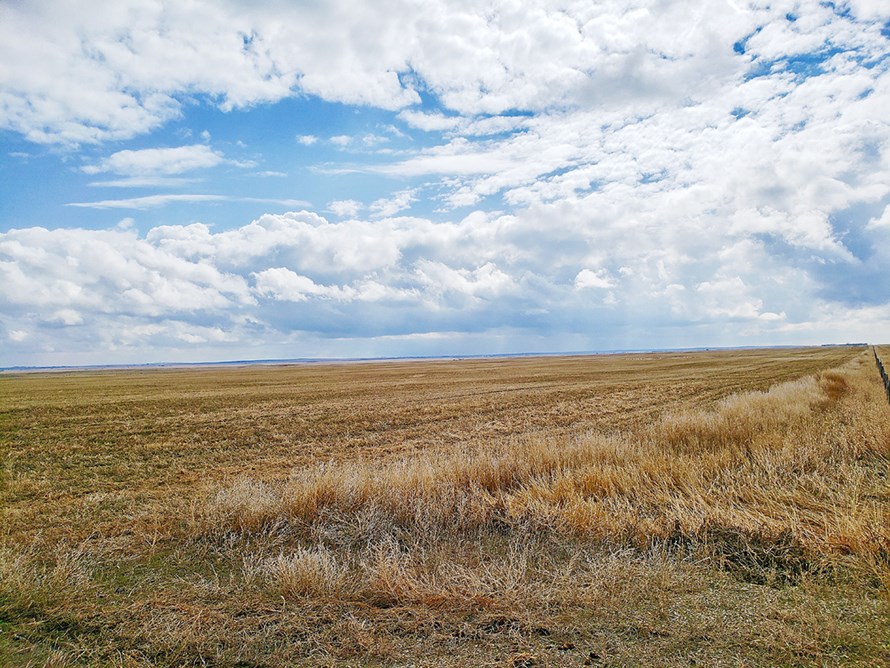Talking on a speakerphone as his truck travelled through Alberta, land real estate specialist Shawn Hansen told Western Investor that demand remains strong for farmland in the province, despite geopolitical headwinds.
As an example, Hansen pointed to a four-quarter (640-acre) parcel he recently listed near Vulcan for $3.1 million. “It sold in two days,” said Hansen, associate broker with Hansen Land Brokers Inc. of High River.
Unlike a decade ago when syndicated investors and big pension funds were driving sales – and controversy – in Western Canada’s farmland market, Hansen and co-broker Bob Dyck said it is now all about existing farm operators getting bigger.
The Vulcan sale, for example, was to a nearby ranch owner looking to expand its pasture and crop lands, Hansen noted.
Hansen and Dyck, who deal in up to $100 million in farmland sales annually, are currently listing land owned by Alberta-based Western Feedlots, one of the largest feedlot operators in Canada, which shut down its operations in 2017 after 60 years in the business.
According to a report in Western Producer, Western Feedlot’s CEO Dave Plett cited the high-risk, low-return environment in cattle ownership, and poor political and economic conditions in Alberta as reasons for the closure.
“Our shareholders see the challenges facing the industry in the next few years are going to be greater,” Plett said.
Cattle industry observers expect other Alberta feedlots to close, citing rising carbon taxes and competition from U.S. suppliers.
Hansen, however, expects to have no problem selling two sections Western Feedlots is selling near High River, one of the three large holdings the company owns in Alberta. Hansen Land Brokers will launch the marketing campaign this June and expects the High River parcels will be priced at around $5,500 per acre.
Western Canada farmland values have tripled in the past two decades, according to the Bank of Montreal, and are rising at around 7 per cent to 8 per cent per year in Alberta, based on the latest data from Farm Credit Canada (FCC).
FCC, which released its 2018 data in mid-April after the Western Investor deadline, noted that Alberta farmland prices increased 7.3 per cent in 2017, down from an average of 9.5 per cent a year earlier.
Hansen said land prices appear to be holding firm this year.
FCC noted that the province has experienced steady sales in all regions, and that there were pockets of strong demand from competing farm operations. Drought-plagued southern Alberta saw increased interest in irrigated land, leading to the region’s overall average increase of 11.4 per cent in land values in 2017 from a year earlier, FCC reported.
Banker John MacAulay, however, has warned that Alberta and other western farmland owners should not take rising farmland values for granted.
“The price of farmland in Canada has roughly tripled over the past two decades, even after adjusting for inflation,” said MacAulay, senior vice-president and divisional head for BMO Bank of Montreal’s Prairies-Central Canada division.
“Despite these gains, it’s worth being cautious any time an asset price turns skyward. Land prices have crashed before and nobody wants to be caught,” he said.
MacAulay said three drivers have kept land demand and prices rising.
- Stronger commodity prices– after adjusting for inflation, Statistics Canada’s broad measure of agricultural prices has risen more than 20 per cent since the mid-2000s amid growing global demand.
- Solid productivity growth– genetic innovations and the adoption of precision technologies have allowed farmers to reduce costs and squeeze ever more production out of a given acre.
- Low interest rates– interest rates have been exceptionally low since the 2007-08 global financial crisis, which has made it economical to bid more for land.
Unfortunately, MacAulay noted, all three of these factors have recently turned against farmland prospects.
Commodity prices are threatened by global factors, such as the China ban on Canadian canola exports, while rising interest rates could increase the value of the Canadian dollar.
“Rising interest rates will [also] raise financing costs, weighing on farm earnings and, potentially, land prices,” he added.
Given the forces at play, it appears unlikely that farmland’s recent strong value gains will be repeated any time soon, he said.
MacAuay said BMO is emphasizing caution and noted that the farm sector’s debt-to-asset ratio is in line with long-term norms, but is higher than before the 1980s farm crisis.



